Handball drills for technique ball control
- Make 6 or 8 columns of players (at least 2 in each column).
- They will have 2 balls in play, with some time distance. (wait until the first ball reaches the middle point and then the second ball starts being passed around)
- The players will have to pass the ball and run to the column they just passed the ball to.
- They will have to be running when they pass the ball, and change passes after a while (normal, bounce, side, underarm,...)
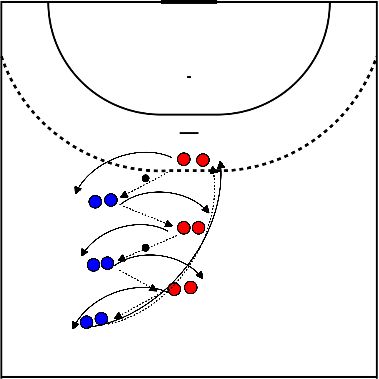
- For the physical condition this is a good exercise:
- The group has to stand in a row and you let them start dribbling easily.
- As soon as the trainer blows the whistle, the last one of the row should run forwards.
- You do this until everyone has been last in line and then you let them run a round relaxed
- Players sit on a chair with a ball.
- Stand up and make three-pass to jump throw and throw at goal (goal, mat, pawn....)
- Points of attention:
- Left - right - jump (left-handers vice versa)
- Arm goes backwards on the right
- Last pass is big
Variations
- Set down and throw over cabinet
- Instead of 3-pass a 2-pass i.e. stand up -right-right-jump
- Mark floor with hats for null pass, catch and drop, and jump shot with 1 or 3 passes.
The players form a line at one end of the court.
- The 2nd player on the line passes the ball to the coach who will be between the centre of the court and the 12 meters.
- The 1st player on the line runs as soon as the pass is made.
- The coach will then pass the ball to the front of the 1st player who is running towards the opposite goal to receive the ball.
- The pass will not be towards the player's hands, but rather to a step in front of where they are, so they continue accelerating.
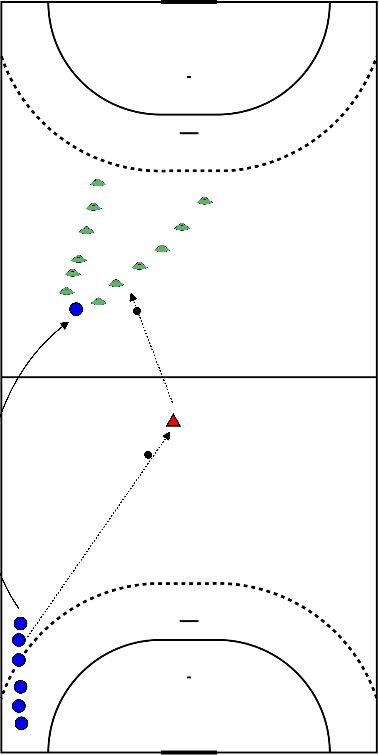
- This can be done with groups of 5 up to 9.
- Let's take a group of 7
- Delineate an area where 4 people can stand and move around with a bit (not too much) room. Place 3 defenders inside, plus 1 line/pivot.
- The remaining 3 attackers will pass the ball around outside the area, with no bounce, and they score a point by either:
- Passing the ball effectively to the pivot
- Placing the ball inside the area without being touched by a defender
- The attackers can move freely, but limited to the 3 steps, 3 seconds with ball in hand, and no bounce.
- If these rules are broken, they become the defenders.
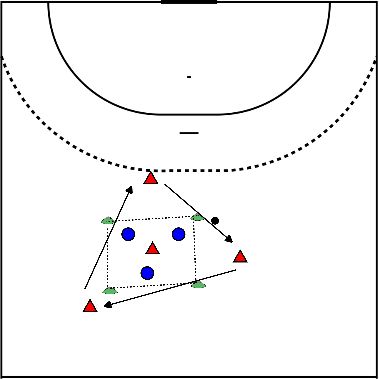
This can be done in groups of 2 or 3 players.
- This is to get used to receiving the ball in motion, facing the goal.
- This is a passing exercise as well.
- Let's take a group of 3 players.
- There will be two cones on the floor, at around 10 meters, on each side of the centre back, and 2 cones at the 7 meters in front of the half backs.
- The centre back has the ball, and for the half back to receive the ball, they need to start behind the cone of the 10 meters, and run in front of it.
- The centre back can only pass the ball in the direction after the cone. Once the half back receives the ball, they will do two/three steps towards the 7 meter cone, stop, and pass the ball back to the centre half who must start before the 10 meter cone and receive the ball after it.
- The half back then returns to their spot and the centre back continues the exercise with the other side half back.
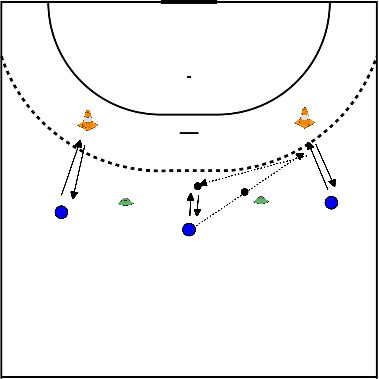
- Depending on how many players there are you can use the full 6/9 meters or just a part of it.
- The defending players will hold hands two by two (so if there are 6 players, there will be 3 groups of 2).
- The attacking players will pass the ball around between themselves and around the area trying to "destabilise" the defence and find a gap so they can run in and touch down with the ball in the area.
- If the 2 groups of the defending players touch the attacker, the point does not count.
- if only 1 of the groups of the defending players touch the attacker, the point counts.
- If none of the groups of the defending players touch the attacker, it counts 2 points.
The goal is to get to 8/10 points (depending on how many 2 points they score) and then swap.
- If there's few players, shorten the court and if there's an uneven number, the defence stays with one less.
Pay attention:
- No lob passes
- No more than 3 passes
- No bounce (if possible)
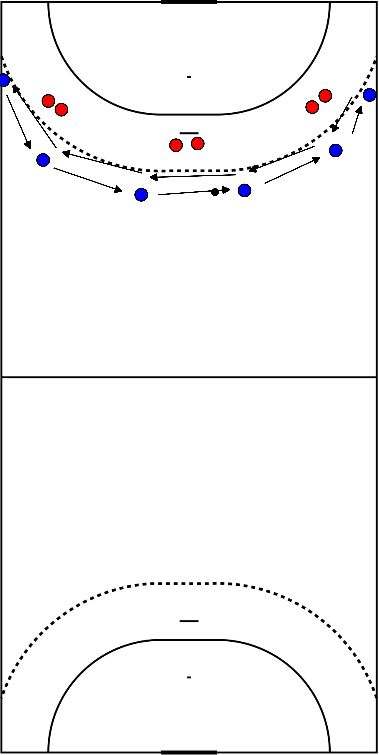
This can be done with groups of 3 to 7 - odd numbers ideally.
- Let's assume a group of 5 players.
- We'll have 3 attackers and 2 defenders.
- The 3 attackers will have a delimited running corridor in a straight line and they will have to pass the ball from one to the others while the 2 defenders will have to try and intercept the passes. The defenders have freedom of movement.
- The exercise can evolve in the types of passes in order to foster movement without the ball.
- First all types of pass, then no lob passes, then only bounce passes.
If the defenders intercept the pass, they continue the exercise acting as the attacking players in numerical inferiority. The 3 attacking players now have no restriction of movement.
This is to be done slowly at first, not as a fast break, to instill the idea of moving without the ball first. The speed can be adapted as the exercise goes on.
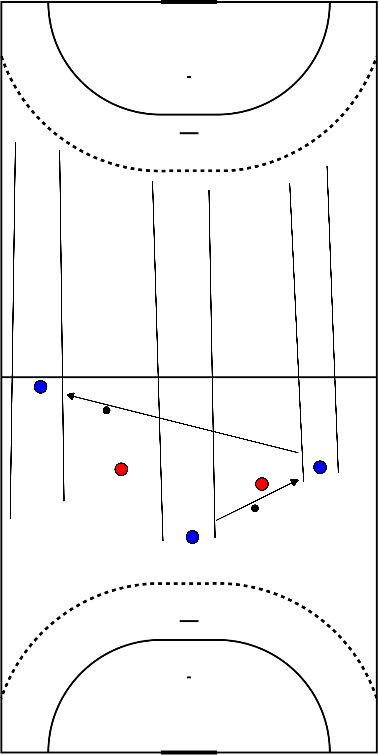
- Make 4 compartments (size depends on the size of the team)
- Everyone starts tipping in box 1
- If you tip the ball away from someone else, you may move up one square.
- Winner is the first to leave the last box
- Have the players practice performing different feints, in the beginning without the ball, as soon as the movement is done well, perform the same movement with a ball.
- Have the players play together in pairs, feinting each time they receive the ball.
- Have them practice a 0 pass on 2 legs.
- Perform the 0 pass on 1 leg.
- Perform the 0 pass on the other leg.
- Have the players perform an 0-pass followed by a feint (shot arm side)
- Having the players make an 0 pass followed by a feint (not shot arm side)
- Working in threes
- One ball is needed per group
- 2 players stand together (with the ball) and the last player stands a few meters away
- The ball carrier always plays to the player on the opposite side
- Everyone runs after the ball after playing
Variation:
- With 4 players making a total of 4 players spread over 3 positions on the field.
- The ball starts where 2 players are standing.
- Still everyone runs after the ball after passing it over.
Duo opposite each other with 1 ball
- Distance 3 meters over throw (pay attention to elbow above shoulder, correct leg and pass on throwing arm)
- In motion (move forward on approach, backward, receive ball and move forward again)
- Increasing distance with bounce (note in hands, bounce just over center)
- Jump shot
- Passing sideways
- Pass too low and catch!
- Pass to high and catch!
- Flyer
- Increase distance
- 2 balls at the same time
- 1 rolls the ball, the other throws








